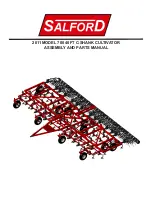
Cleaning, maintenance and repairs
Centaur BAG 0070.1 12.08
99
11.11.1 Labelling hydraulic hose lines
The assembly labelling provides the
following information:
Fig. 62/...
(1) Manufacturer's marking on the hydraulic
hose line (A1HF)
(2) Date of manufacture of hydraulic hose line
(04/02 = year/month = February 2004)
(3) Maximum approved operating pressure
(210 BAR).
Fig. 62
11.11.2 Maintenance
intervals
After the first 10 operating hours, and then every 50 operating
hours
1. Check all the components of the hydraulic system for tightness.
2. If necessary, tighten screw unions.
Before each start-up:
1. Check hydraulic hose lines for visible damage.
2. Eliminate any scouring points on hydraulic hose lines and pipes.
3. Replace any worn or damaged hydraulic hose lines immediately.
11.11.3 Inspection criteria for hydraulic hose lines
For your own safety, comply with the following inspection criteria!
Replace hydraulic hose lines, on determining any of the
following during the inspection:
Damage to the outer layer up to the ply (e.g. scouring points,
cuts, cracks).
Brittleness of the outer layer (crack formation of the hose
material).
Deformations which do not match the natural shape of the hose
or the hose line. Both in a depressurised and pressurised state
or when bent (e.g. layer separation, bubble formation, pinching,
bends).
Leak
points.
Damage or deformation of the hose assembly (sealing function
restricted); minor surface damage is not a reason for
replacement.
Movement of the hose out of the assembly.
Corrosion of assembly, reducing the function and tightness.
Installation requirements not complied with.








































